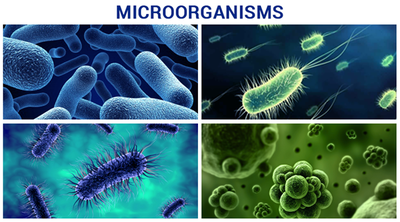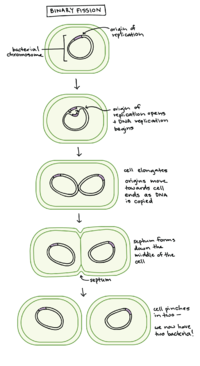Microorganisms: Difference between revisions
No edit summary |
No edit summary |
||
| Line 13: | Line 13: | ||
[[File:binary_fission.png|200px|right|thumb| [2] ]] | [[File:binary_fission.png|200px|right|thumb| [2] ]] | ||
'''Step 1''': At the origin of previous replication, the strand of DNA begins to unravel and prepare for replication. | '''Step 1''': At the origin of previous replication, the strand of DNA begins to unravel and prepare for replication. | ||
Revision as of 07:06, 9 May 2018
Definition

A microorganism is a form of life that can be single celled and can be formed in colonies of cells. These forms of life are almost all microscopic. The three main microorganisms are bacteria, fungi, and viruses. These microorganisms are extremely vital in everyday processes and especially in soil processes. [1]
Bacteria
A bacteria is a single celled microorganism or "microbe", that does not have a nucleus or any membrane bound organelles, therefore it is a Prokayote. The bacteria has a single loop of DNA which acts as the nucleus of the organism. Often there can be another strand of DNA that gives the bacteria a distinguishing feature that typically helps with survival. An example of this is the ability for some bacteria to be resistant to certain antibiotics, or some bacteria being able to survive in conditions with a higher pH than typical bacteria.
Bacteria reproduce by binary fission which means the single cell will split into two daughter (identical) cells, which then split into four, and so forth. Replication by binary fission is often a very fast process, but there are a few important steps involved.

Step 1: At the origin of previous replication, the strand of DNA begins to unravel and prepare for replication.
Step 2: The cell then elongates two prepare to slit and to contain both copies of the DNA.
Step 3: A septum forms down the center of the cell which is the start of the cell splitting. In this phase, the DNA migrate to each side of the cell.
Step 4: The septum continues down the entire cell and the cell splits into two identical cells.
References
[1] Nationwide, SARE. “Soil Microorganisms.” SARE: Sustainable Agriculture Research and Education, www.sare.org/Learning-Center/Books/Building-Soils-for-Better-Crops-3rd-Edition/Text-Version/The-Living-Soil/Soil-Microorganisms.
[2]